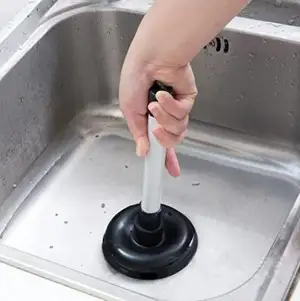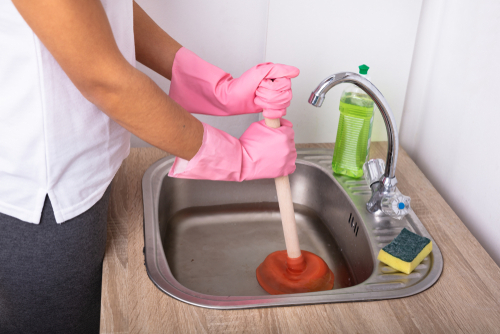Utilizing Plunger and Drain Cleaners: Pro Strategies
Utilizing Plunger and Drain Cleaners: Pro Strategies
Blog Article
This great article down below relating to How To Use Your Toilet Plunger Correctly in 5 Easy Steps is rather remarkable. You should take a look.

Introduction
Proper maintenance of household drains pipes is essential for preventing obstructions and making certain smooth water circulation. One of the trick tools in every house owner's toolkit is the bettor, alongside various drainpipe cleaners made to take on persistent blockages effectively. This short article discovers how to make use of bettors and drain cleansers efficiently to maintain your drains flowing openly.
Area 1: Comprehending Plungers
Sorts of Plungers
There are a number of sorts of plungers available, each created for different sorts of drains and blocks. One of the most typical kinds include cup bettors, flange bettors, and accordion plungers.
Just How Plungers Work
Plungers service the concept of creating pressure and suction to remove obstructions. When properly applied over a drain, they produce a vacuum cleaner that can take out particles or separate blockages.
Choosing the Right Plunger
Choosing the ideal bettor relies on the type of drain and the nature of the clog. Cup plungers are suitable for sinks and tubs, while flange plungers are better suited for toilets due to their layout.
Common Errors with Bettors
Avoiding these mistakes ensures reliable plunging: inappropriate seal around the drain, insufficient pressure, and unclear surrounding debris.
Area 2: Utilizing Plungers Effectively
Prep work
Before diving, ensure the bettor covers the drain totally and forms a limited seal. Clear any noticeable debris around the drainpipe opening.
Method
Beginning with gentle diving movements to build suction. Rise pressure slowly, making use of a stable rhythm. Repeat as essential until the drain removes.
Repairing Tips
If plunging doesn't work, attempt readjusting the seal, using petroleum jelly for a much better seal, or utilizing a various sort of bettor.
Section 3: Comprehending Drainpipe Cleaning Company
Types of Drain Cleansers
Drain pipes cleansers can be chemical or enzymatic. Chemical cleaners use strong chemicals to dissolve clogs, while chemical cleansers make use of all-natural enzymes to break down organic matter.
Exactly How Drain Cleaning Company Work
Chemical cleaners respond with clogs to liquify them, while enzymatic cleansers break down natural materials like hair and oil without harming pipes.
Security Factors to consider
Constantly wear handwear covers and eye protection when utilizing chemical drainpipe cleaners. Ensure appropriate air flow and follow maker guidelines thoroughly.
Eco-Friendly Alternatives
Take into consideration using vinegar and baking soda or enzyme-based cleaners for green alternatives that are safer for pipelines and the environment.
Section 4: Using Drainpipe Cleaners Effectively
Application Strategies
Put chemical cleansers straight into the drain opening. Allow them to benefit the advised time prior to purging with hot water. Enzymatic cleansers must sit overnight.
Preventative measures
Stay clear of blending various sorts of cleansers, as this can create hazardous fumes. Never utilize chemical cleaners along with a plunger, as spilling can take place.
Managing Stubborn Clogs
For relentless obstructions, take into consideration utilizing a pipes serpent or calling a specialist plumbing technician to avoid damages to pipes.
Conclusion
Finally, understanding how to make use of bettors and drain cleaners successfully is vital for maintaining healthy pipes systems. By picking the right devices and strategies, homeowners can tackle small obstructions and protect against significant pipes problems down the line.
How To Properly Use A Plumbing Snake To Clear Drains
When any drain clogs in our home arise, we tend to gravitate toward the plunger and little else. In cases where the plunger and its vacuum-created pressure are not able to clear clogs, many immediately move to harmful chemicals or simply call their plumber to fix the issue.
we’re happy to help with all drain cleaning needs and concerns. This includes informing you on a few other home remedies you may have at your disposal for minor to moderate clogs, one of which is the use of a plumbing snake. Many people have never used one of these before – let’s go over the steps to take when your drain clogs and you have a plumbing snake available.
Attempt Plunger Use
The first step here, as we noted above, should indeed be to grab your plunger when you notice a drain clog and attempt to resolve it this way. If you’re unsure how to use a particular type of plunger, our plumbers can answer any questions you have. If this doesn’t do the trick, however, you move on to the snake.
Locate And Prepare Snake
A plumbing snake is a metal or plastic device that’s generally about a quarter of an inch thick. It’s design with significant extensions, meant to reach down into your clogged drain and push the clog out. Snakes also contain drain augers that will latch onto and push stubborn blockages.
If your plunger doesn’t clear a clog, locate your snake and bring it to the drain in question. We also recommend keeping a bucket nearby to collect the clog once you pull it out, plus we’d advise wearing goggles and possibly protective gloves.
Feed Snake
Once you’re ready to go, feed the snake slowly down the drain, using the crank device it comes with to keep it moving until it finds the clog. Once this happens, much of the clog will be latched onto the coil so you can pull it out, while the rest will simply break up and flow downward.
Detach Debris
Remove the snake slowly from the drain, and once you’ve done so, pick off any debris that’s stuck to the coil. This is another area where wearing gloves is a must.
Flush Drain
Finally, take a few minutes to ensure the snake has done its job correctly. If you’ve been using it on a toilet, flush the toilet a couple times and make sure everything flows well. If you’ve used it on a different drain, flush it with some room temperature water.
https://www.mybuddytheplumber.com/blog/how-to-properly-use-a-plumbing-snake-to-clear-drains/

Application Strategies
Put chemical cleansers straight into the drain opening. Allow them to benefit the advised time prior to purging with hot water. Enzymatic cleansers must sit overnight.
Preventative measures
Stay clear of blending various sorts of cleansers, as this can create hazardous fumes. Never utilize chemical cleaners along with a plunger, as spilling can take place.
Managing Stubborn Clogs
For relentless obstructions, take into consideration utilizing a pipes serpent or calling a specialist plumbing technician to avoid damages to pipes.
Conclusion
Finally, understanding how to make use of bettors and drain cleaners successfully is vital for maintaining healthy pipes systems. By picking the right devices and strategies, homeowners can tackle small obstructions and protect against significant pipes problems down the line.
How To Properly Use A Plumbing Snake To Clear Drains
When any drain clogs in our home arise, we tend to gravitate toward the plunger and little else. In cases where the plunger and its vacuum-created pressure are not able to clear clogs, many immediately move to harmful chemicals or simply call their plumber to fix the issue.
we’re happy to help with all drain cleaning needs and concerns. This includes informing you on a few other home remedies you may have at your disposal for minor to moderate clogs, one of which is the use of a plumbing snake. Many people have never used one of these before – let’s go over the steps to take when your drain clogs and you have a plumbing snake available.
Attempt Plunger Use
The first step here, as we noted above, should indeed be to grab your plunger when you notice a drain clog and attempt to resolve it this way. If you’re unsure how to use a particular type of plunger, our plumbers can answer any questions you have. If this doesn’t do the trick, however, you move on to the snake.
Locate And Prepare Snake
A plumbing snake is a metal or plastic device that’s generally about a quarter of an inch thick. It’s design with significant extensions, meant to reach down into your clogged drain and push the clog out. Snakes also contain drain augers that will latch onto and push stubborn blockages.
If your plunger doesn’t clear a clog, locate your snake and bring it to the drain in question. We also recommend keeping a bucket nearby to collect the clog once you pull it out, plus we’d advise wearing goggles and possibly protective gloves.
Feed Snake
Once you’re ready to go, feed the snake slowly down the drain, using the crank device it comes with to keep it moving until it finds the clog. Once this happens, much of the clog will be latched onto the coil so you can pull it out, while the rest will simply break up and flow downward.
Detach Debris
Remove the snake slowly from the drain, and once you’ve done so, pick off any debris that’s stuck to the coil. This is another area where wearing gloves is a must.
Flush Drain
Finally, take a few minutes to ensure the snake has done its job correctly. If you’ve been using it on a toilet, flush the toilet a couple times and make sure everything flows well. If you’ve used it on a different drain, flush it with some room temperature water.
https://www.mybuddytheplumber.com/blog/how-to-properly-use-a-plumbing-snake-to-clear-drains/

As a fervent person who reads about Here's How to Correctly Use a Toilet Plunger, I imagined sharing that piece of content was worth the trouble. In case you appreciated our post please consider to pass it around. We take joy in reading our article about Tips on How to Effectively Use a Plunger.
Free Estimate Report this page